Support Napa Valley Features – Become a Paid Subscriber Today
If you’re reading this, you care about independent, locally owned, ad-free journalism — reporting that puts our region’s stories first, not corporate interests or clickbait.
Join a community that values in-depth, independent reporting. Become a paid subscriber today — and if you already are, thank you. Help us grow by liking, commenting and sharing our work.
Green Wednesday: Gardening and Ecological Insights
Every Wednesday Napa Valley Features brings you Green Wednesday, featuring articles from environmental voices and the UC Master Gardeners of Napa County. These contributors share research-based horticultural advice and insights on sustainability and climate topics relevant to our region.
Summary of Today’s Stories
"Cunning Crows and Ravens" by Kathleen Scavone, environmental contributor:
Crows and ravens, members of the highly intelligent corvid family, display remarkable problem-solving skills, tool usage and adaptability to changing environments. This article examines their distinguishing characteristics, habitats and the intriguing behaviors observed by experts such as Ashley Kvitek of the Napa Resource Conservation District, highlighting how these birds have thrived for millions of years while captivating human curiosity and folklore.
“An unkindness is what a group of ravens is called, or if you prefer, it can be called a ‘conspiracy,’ and the collective noun for a group of crows is a ‘murder of crows.’” - Kathleen Scavone
"The Art of Grafting" by Cindy Watter, UC Master Gardeners of Napa County:
Grafting, an ancient horticultural technique practiced for thousands of years, is used to propagate fruit trees, especially apples, ensuring desirable fruit characteristics and disease resistance. This article explores a recent workshop led by Ryan Raes of California Rare Fruit Growers, where participants learned hands-on grafting methods, including cleft grafting, and gained insight into the historical significance and practical applications of this essential gardening skill.
“My walnut tree is an English walnut grafted onto a black walnut rootstock for better disease resistance.” - Cindy Watter
Cunning Crows and Ravens
By Kathleen Scavone
NAPA VALLEY, Calif. — The Napa Valley has been influenced over time by many factors with its eventful geologic history that created the Mayacamas Mountains on the west and across the valley the Vaca Range to the east. Add to that the 55-miles-long Napa River that meanders the contours of the valley down to the intertidal zone of fresh- and saltwater all of the way to the San Pablo Bay. Then you begin to note the tapestry created by the topography of this wild and rich land that is comprised of much more than its famed vineyards. Since the county is a stop on the migratory route called the Pacific Flyway, Napa's forests, grasslands and wetlands allow for hundreds of bird species to migrate, with many living here year-round.
American crows (Corvus brachyrhynchos) and common ravens (Corvus corax) are both in the corvidae, or corvid family of passerine birds, that also include jays that reside in Napa County. They are both big, black birds and are sometimes hard to differentiate. One way to tell them apart is by sound. The Napa Solano Audubon Society lists both bird sounds in a link on their website and also posts an amazingly long checklist of common birds in Napa County that is worth a look.
Ashley Kvitek, community engagement project manager at Napa Resource Conservation District, knows all about the corvid family of birds in the Napa Valley. Kvitek earned a master’s degree in environmental education from Western Washington University, where she studied ravens as part of that program during her teaching residency in North Cascades National Park at the North Cascades Institute.
"I spent a year paddling and hiking around two glacial lakes following two mating pairs of ravens and observing and documenting their journey creating the next generation of life,” she said. “I watched their feeding behaviors, saw the fledglings learning to fly and could tell when the adolescents joined the juvenile unkindnesses in the area."
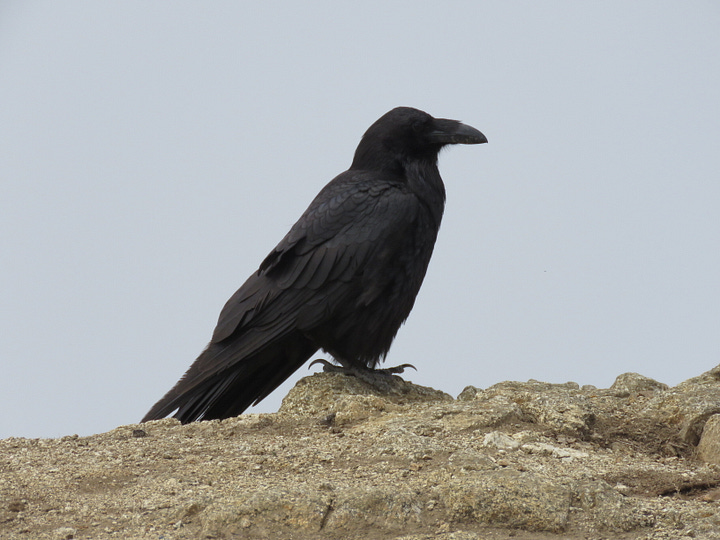
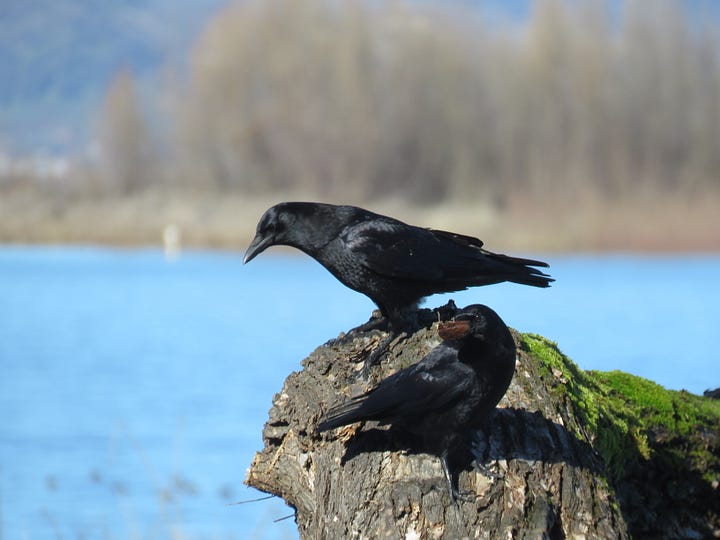


An unkindness is what a group of ravens is called, or if you prefer, it can be called a “conspiracy,” and the collective noun for a group of crows is a murder of crows or a horde, which may give an inkling of the reputation the birds had garnered even before Alfred Hitchcock directed his memorable movie “The Birds.” (“The Birds” was a movie set in Bodega Bay and featured scenes that created an ornithophobic condition or fear of birds in many people.)
Kvitek gave a short educational talk on ravens that can be viewed on the Napa County Regional Parks and Open Space District YouTube site. Called “Ravens at Rector Ridge,” it was filmed at Rector Reservoir Wildlife Area northeast of Yountville. The California Department of Fish and Wildlife explains that the Rector Reservoir Wildlife area is comprised of 433-acres of mixed chaparral and oak woodland vegetation and is a popular destination for its wildlife-viewing, hiking, fishing and hunting. It is owned by the Department of Veterans Affairs and managed by CDFW with around 40 bird species and more than a dozen species of reptiles and amphibians that have been identified there.
Rector Ridge trail in Yountville provides opportunities for great hiking and wildflower viewing in springtime. The updraft from the reservoir at the ridge is also a great place to watch ravens, according to Kvitek.
"There are so many amazing things about ravens, I could — and have — talked about them for hours at a time,” she said. “In the pretty recent past, ravens were found in more rural areas while crows were found in more urban spaces. To this day, ravens exist in fairly sparse population groups while crows live in family groups that can number in the hundreds or thousands. The two bird species aren't found comingling very often. Their territories are pretty divided, and it's rare to see them in the same place unless you are in a newly developed section of the wildland-urban interface."
That being said, Kvitek was amazed to learn about an exception to the rule, since there is a pair of ravens living happily among the crows in downtown Napa.
“I had never seen it before in 14 years of studying and watching ravens and crows, and could hardly believe it when I moved here almost six years ago and heard both crow and raven calls on my front steps in the evening,” Kvitek said. “I had moved to Napa from a more rural area, and as I explore the Bay Area, I'm finding this is not an uncommon thing to see in areas that have a lot of urban sprawl. Always learning new things!"
Tips on how to distinguish the difference between ravens and crows, Kvitek said, are to first note your location. Depending upon if you are in a more remote or wild location, you will most likely see a raven, while crows are a more urban avian species. Another way to differentiate the birds is by noting the shape of their tails. A crow's tail is almost straight across at the bottom of its tail, while a raven tail is more rounded. Another differentiation is by beak shape, since a crow has a conical-shaped beak that reaches a straight point, while a raven's beak comes out and down from its face.
Corvids such as ravens and crows are opportunistic omnivores, feeding on eggs, nesting birds, fruit, insects and carrion. Crows reach 17-20 inches in length with 32- to 40-inch wingspans while ravens are 24 to 27 inches long with 46- to 54-nch wingspans. In flight ravens might soar, while their cousins the crows fly with a rowing wing-beat. A raven also possesses shaggy throat feathers to help distinguish them from crows.
In “Birds of Napa County,” author Hermann Heinzel speaks of American crows and common ravens as being residents across Napa County. While crows nest in trees or large shrubs, ravens nest in tall trees or cliffs. The National Audubon Society book titled “The Sibley Guide to Bird Life & Behavior,” illustrated by David Allen Sibley, informs readers that corvid intelligence is, indeed, remarkable. Ravens have been understood to nonverbally count and to perform psychological tests with results comparable to monkeys. Crows know how to drop nuts on pavement in order to crack the tough shells to then get at the nut meat. Other experiments show that both bird species are quite remarkable at solving various problems when presented with novel tasks.
Evolutionary biologists such as Joan Garcia-Porta are learning just how bird-brained these corvids are, with the adjective bird-brained not used as a pejorative. In an April 2022 issue of the online magazine Popular Science, the author explains that in order for crows and ravens to have survived so long they have been introduced to ever-changing environments and have adapted quickly to changes and possess cognitive abilities comparable to adult apes.
Surprisingly enough, both crows and ravens have the ability to utilize tools and can mimic human speech. The online research news source Science Daily concurred as to the intelligence of both crows and ravens in a piece from Washington University in St. Louis. These avian species have evolved to thrive across the world. Their global diversification is a result of their great flight skills with big wing spans and their big brains relative to their size.
Both crows and ravens have roused mythic thoughts across cultures and time, possibly because the raven is understood by scientists to have been around in the Pleistocene era, 1.8 million to 10,000 years ago, and crow species have been around for about 5 million years. Throughout time corvids have been associated with both good and bad luck, and they are renowned for their adaptive and intelligent habits. It is such a pleasure and privilege to take in nature's theater-in-the-round in the great outdoors while gaining knowledge of some of the mysteries of the wild.
Kathleen Scavone, M.A., retired educator, is a potter, freelance writer and author of “Anderson Marsh State Historic Park: A Walking History, Prehistory, Flora, and Fauna Tour of a California State Park,” "People of the Water" and “Native Americans of Lake County.” She loves hiking, travel, photography and creating her single-panel cartoon called “Rupert.”
The Art of Grafting
By Cindy Watter, UC Master Gardener of Napa County
NAPA VALLEY, Calif. — Among the pleasures of being a UC Master Gardener are the monthly seminars where we are instructed by experts. Some of these authorities are homegrown; others are imported. One recent speaker was Ryan Raes of California Rare Fruit Growers, a nonprofit organization for amateur rare-fruit enthusiasts. He spoke to us about grafting fruit trees, especially apple trees.
Raes told us that people have been grafting plants for thousands of years. The ancient Egyptians and Chinese knew how to graft. In Renaissance Europe, grafting became almost a mania. Our Napa Valley wine grapes are grafted onto rootstock. The roses in Napa’s Fuller Park are also grafts. My walnut tree is an English walnut grafted onto a black walnut rootstock for better disease resistance. The three apple trees I planted a few years ago are grafted.
People graft apple trees for many reasons. The main one is that apple trees planted from seed almost always produce fruit with inferior flavor to the fruit from the parent tree. John Chapman, aka Johnny Appleseed, planted thousands of apple seeds across the American frontier, but those seeds produced apple trees whose fruit was only suitable for hard cider (which probably didn’t bother the pioneers).
Grafting also allows you to propagate rare varieties. Raes makes grafts from apple trees that are almost extinct, and he owns two apple trees that are the last of their kind. Grafting is an economical way to develop a fruit orchard. And it’s fun.
Raes showed us how to graft a scion (a branch from a tree that you want to reproduce) onto rootstock. Groups of us sat at tables and did a hands-on activity where one of us made the grafting cuts and the rest of us shrieked “Be careful!” Grafting knives are sharp. When he told us that his 6-year-old son grafts trees, I immediately felt incompetent. I would have sliced off my thumb had I not been wearing leather gloves.
He also told us about grafting multiple stone-fruit varieties — including cherry, white peach and apricot — onto a fruit tree at his home. Alas, when he sold the home, the new owner chopped it down.
Raes kept us entertained with his apple-themed anecdotes and trivia. Did you know that Lake Hennessey used to be an apple orchard? Or that grafting a crabapple branch onto an apple tree will improve pollination?

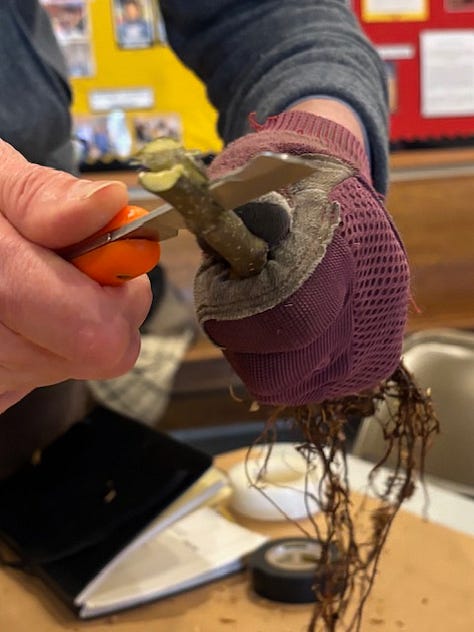
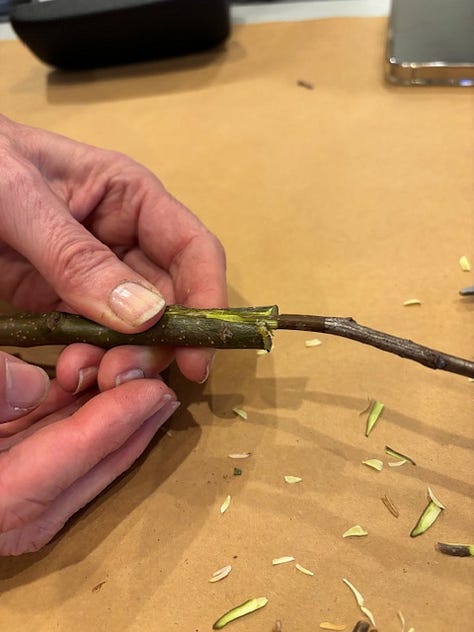

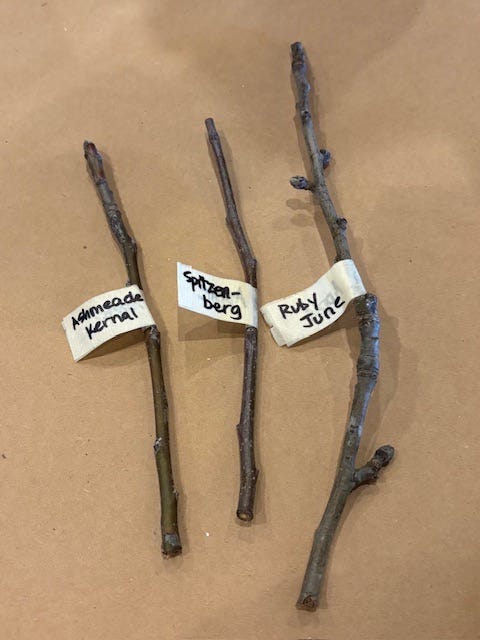
It is best to get rootstock and scions for grafting from local sources, such as nurseries, because they stock varieties that are suitable for our climate. You can also obtain rootstock and scions from members of specialist plant societies such as the California Rare Fruit Growers.
Important to know: Some fruit tree cultivars are protected by patents. If you buy or obtain a patented plant, you can’t propagate it without the permission of the patent owner.
During the hands-on portion of Raes’ workshop, we cut off the rootstock about a foot above the base. This was a straight cut. Next I used a new grafting knife to make a 2-inch slice in the stem of the rootstock, slowly rocking the knife back and forth. After the knife slipped and I nearly cut myself, someone more adept took over. Raes said the knife wasn’t sharp enough. Even new knives need to be sharpened. Some people use a vise to hold the rootstock for this step.
We had three choices of apple scions: Ashmead’s Kernel, Spitzenburg and Ruby June. My group picked Spitzenburg because it was Thomas Jefferson’s favorite variety. The scions all had dormant buds, so it was the ideal time for grafting.
We cut our scion a few inches from the top and peeled off the thin bark — an easy task with a small, sharp knife. The reason for peeling is to expose the cambium, the layer directly under the bark that is actively producing new cells of plant tissue. A team member inserted the prepared scion into the slit in the rootstock, taking care to line up the scion cambium with the rootstock cambium. If the two cambiums are properly aligned, they will grow together and the graft will be a success.
Some people use rubber bands, twine or grafting wax to keep the rootstock and scion attached, but Raes prefers a grafting tape called Parafilm. It stays in place long enough for the graft to take, and then it falls off. Grafting tape won’t girdle the tree, which can inhibit growth. The graft union should be kept moist until the wound has healed. Label your tree and keep a separate record in the house as a backup since labels can vanish.
Our table gave the Spitzenburg graft to a Master Gardener who lives in Pope Valley, a colder part of Napa County better suited to this Eastern apple.
This type of grafting, known as cleft grafting, is the easiest to do. Raes showed us other techniques, such as whip-and-tongue grafting. This involves a diagonal cut, in which the scion and rootstock fit together like a puzzle.
Raes recommended “The Grafter’s Handbook” by R.J. Garner for novice grafters. “The California Master Gardener Handbook” is also helpful. Be sure your tools are extra-sharp and put on those heavy gloves.
Events
Workshop: Join UC Master Gardeners of Napa County for a workshop on “Backyard Composting” on Saturday, March 22, from 10 a.m. to noon, at Hagafen Cellars, 4160 Silverado Trail, Napa. Enrich your soil health by turning your food waste into an amendment your plants will love. Learn several composting methods you can do in your own backyard. This workshop is a collaboration with the City of Napa. Compost bins will be available for purchase at a reduced price. Registration required.
Workshop: Join UC Master Gardeners of Napa County for “Viticulture Q&A: Understanding Grape-Growing Practices” on Saturday, March 29, from 9 a.m. to noon. This home-vineyard workshop will provide an overview of three approaches: organic/sustainable, dry farming/deficit irrigation and climate-conscious conventional viticulture. Topics include basic farming techniques, a vineyard planting checklist and management techniques for common pests. The workshop location (in Napa) will be provided in your registration confirmation email. Register here.
Tomato Plant Sale: The annual Napa County Master Gardeners Tomato Plant Sale is Saturday, April 12, from 9 a.m. until sold out at 1710 Soscol Ave. in Napa. Seedlings are grown locally by Master Gardeners and are $5 each. Stop by the education tables and consult with our tomato pros. The list of available varieties is here.
Help Desk: The Master Gardener Help Desk is available to answer your garden questions on Mondays and Fridays from 10 a.m. until 1 p.m. at the University of California Cooperative Extension Office, 1710 Soscol Ave., Suite 4, Napa. Or send your questions to mastergardeners@countyofnapa.org. Include your name, address, phone number and a brief description of the problem. For best results attach a photo.
Cindy Watter is a UC Master Gardener of Napa County.
—


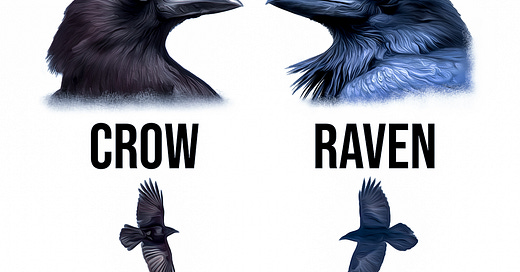








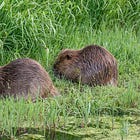





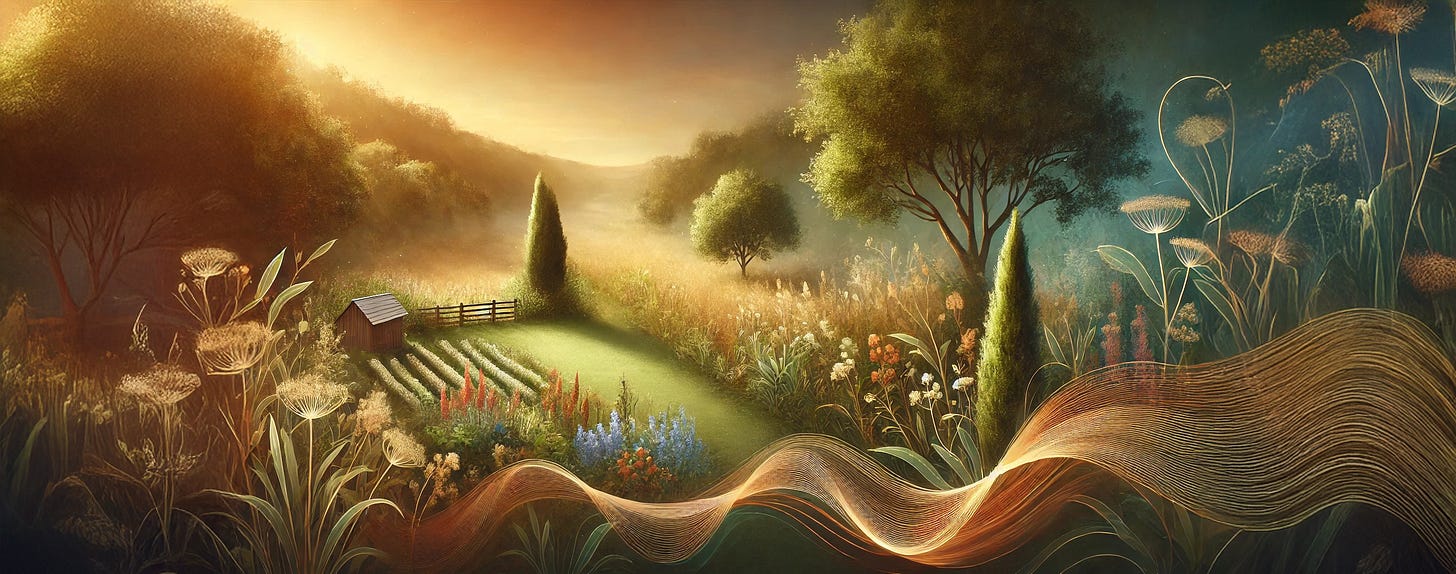
We have several ravens living around our place above the Berryessa Highlands. A pair of them made their home in a big nest in a tree in a small valley below our house. We have a big sloping field below our deck we jokingly refer to as our "outdoor compost bin" onto which we bestow our leftover food scraps (never meat in the country). I enjoy watcing them in action soaring across my field of view, calling to each other as they perch in our tree branhches, and at times on our deck railing, scanning for bread crusts or vegetable trimmings.
One reason I was originally able to determine that our birds were ravens, not crows, was their distictive call. There's a good audio story about ravens at the Audubon Society website with sounds of their calls. It describes our raven couple in detail. They've been with us at Lake Berryessa for many years.
https://www.audubon.org/news/listen-sweet-soft-warble-common-ravens-sing-their-partners